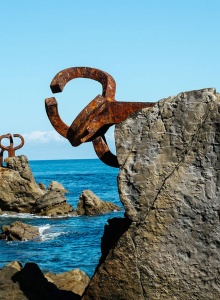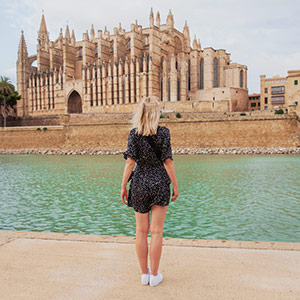This coastal city is spread along a bay of white sand between the Urgull and Igeldo mountains.
A fishing hamlet, the city's stately expansion and modern neighbourhoods make this one of the most attractive cities on the Cantabrian coast. The San Telmo Museum, the Peine del Viento and the Kursaal Conference Centre are examples of how the city combines tradition and modernity. In turn, the province of Guipuzcoa, with San Sebastián as its capital, combines the sea and mountains, offering visitors, in addition to interesting monuments, landscapes, sports, gastronomy, etc. Internationally renowned Basque gastronomy.
The urban layout of San Sebastián unfolds overlooking the Bay of La Concha. Mount Igeldo marks the limit at one end, an unbeatable vantage point to enjoy the views over the city. At its feet is Punta Torrepea, where the “Wind Comb”, is installed, a sculptural group by the famous Basque artist Eduardo Chillida. Here is where Ondarreta Beach begins, framed by a green space and Pico del Loro, a tiny cape that separates this beach from the next, La Concha. This spot was chosen by Queen Maria Cristina (19th century) to build the Miramar Palace, her summer residence. A beautiful promenade with elegant railings and lamp posts connects to La Conchabeach, where the La Perla Spa, a former royal bathhouse, stands upon its sands.Without ever losing sight of the sea, next up is the former Casino, now the city's Town Hall. In this area, between the sea and the Urumea River is the old town, and on the way to Monte Urgull, the sports pier and the fishing district. Castillo de la Mota and a statue of the Sacred Heart look down on the city from Monte Urgull. One path takes us to the top, while another goes around the mountain taking us along the Paseo Nuevo breakwater.
Old quarter
The oldest part of San Sebastián is home to the churches of San Vicente and Santa María del Coro, one Gothic in style and the other Renaissance-baroque. A former Dominican convent now hosts San Telmo Museum, worth a leisurely visit on account of its archaeology, ethnography and art collections. These bustling streets lead visitors to the porticoed Plaza de la Constitución. Amongst the balconies in this square, numbered and marked with chalky sand that reveal its origin as a bullring, stands the former neoclassical town hall, converted into the municipal library.The Alameda del Boulevard gives ways to the romantic city, which as constructed following the demolition of the old city walls. On the banks of the River Urumea are the Victoria Eugenia Theatre and the María Cristina Hotel, which is Neoplateresque in style. Scattered along this rationalist layout we can also visit the landscaped Gipuzkoa square, with the Provincial Council building, the Koldo Mitxelena Cultural Center, and the Post Office and Telegraph Office. This is in addition to the Cathedral of San Sebastian, the Good Shepherd, constructed in the neo-Gothic style. Again on the riverbank there are many stately houses from the beginning of the 20th century, which will lead us to the María Cristina bridge, the most monumental of those that cross the river. Four street lamps by the sculptor Mariano Benlliure illuminate the path to the railway station. On this side of the river are the modern neighborhoods of Egia and Gros. On Gros beach there is the modern structure of the Kursaal, designed by the architect Rafael Moneo.San Sebastián is a cosmopolitan city with a resolutely Basque character, as is reflected in its cultural events. The Tamborrada or the Semana Grande, with its trainera regattas, pay testament to the city's tradition; while its prestigious film and jazz festivals say much about its international vocation. Occasions, all of them, in which it is worth enjoying the city, even if it is necessary to reserve accommodation in advance.
Guipúzcoa
One of the best ways to explore its neighborhoods and get closer to its culture is through gastronomy. Basque cuisine is internationally famed given the quality of its raw materials and the excellent work of its traditional and imaginative chefs alike. Some of Spain's most renowned restaurants can be found in San Sebastián. Dishes prepared using garden products, fish and seafood must be washed down with a chacolí from Guetaria/Guetariako Txakolina, with its own Designation of Origin.The province of Guipúzcoa has something for everybody, offering an extensive coastline of excellent beaches and fishing villages, as well as natural spaces inland that are home to important historical towns. Traveling along the coast from France to Vizcaya, visitors have the opportunity to visit the historic quarter of Hondarribia/Fuenterrabia, declared a Historical-Artistic Monument, and to stay at its Parador de Turismo. Other towns that boast both interesting monuments and extensive beaches include Zarautz, Getaria, Deba and Mutriku.Rivers and valleys guide us through the interior of the province. Following the course of the Oria, the historic towns of Tolosa, Ordizia and Lazkao preserve important monumental legacies. The Urola Valley is home to the old town, the medieval layout of Azpeitia and the Sanctuary of San Ignacio de Loyola, a baroque complex that is at the heart of Basque religiousness. Bergara, one of the most stately towns in Guipúzcoa and beautiful hamlets like Elgeta spread across the Deba valley.In addition to this wealth of monuments, this province in the Basque Country boasts an outstanding natural environment that is perfect for practicing a variety of sports with a low environmental impact. The natural parks of Aitzkorri, Aralar, Aiako Harria and Pagoeta are also worth particular mention given the quality of their ecosystems.
















